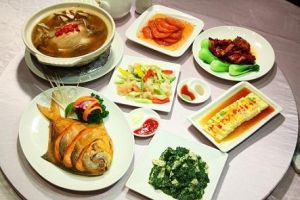Jiangsu Zhejiang Cuisine
Jiangsu refers to the part of Jiangsu south of the Yangtze River, namely Suzhou and Wuxi; while Zhejiang refers to the western part of the province, namely Hangzhou and Huzhou. The economy in the two provinces began growing after the middle of the Tang Dynasty (around the 5th century). Following the Five Dynasties (907 - 960), the economic and cultural centers moved south, and literati gathered in these places. If the catering trade in Huai'an and Yangzhou chiefly met the needs of important, rich traders, the cooking skills and features in this area reflected the interests and tastes of the literati.
Jiangsu and Zhejiang cuisine stresses the use of vegetables, bamboo shoots, mushrooms, and water shield, which gives the food a light, fresh taste. Vegetable dishes make up the bulk of the common people's daily meals, but also are popular dishes on the menus of famous restaurants. These dishes include cabbage heart cooked in chicken fat, braised fish slivers, spring bamboo shoots braised in oil, spinach flavored with shrimp sauce, West Lake live fish steamed with vinegar, and water shield soup. Fish or meat dishes are often cooked together with vegetables; and fish, shrimp, crab, and mussels from the rivers and lakes are also served as delicacies. In this area the fish and shrimp are often kept alive until they are cooked, so the foods served in restaurants are very fresh.
The Jiangsu � Zhejiang cuisine has many famous fish and shrimp dishes. For example, Mandarin Fish Shaped like a Squirrel topped with sweet and sour tomato sauce was praised by Emperor Qianlong of the Qing Dynasty as the "the Number One Dish in the World." West Lake fish steamed in vinegar has been famous for centuries, minced perch in Songjiang has been praised for a millennia, and braised shrimp served with Longjing tea in Hangzhou and braised shrimp served with Biluo Spring tea are both very popular.
Jiangsu � Zhejiang dishes are slightly sweet and less salty, but some dishes are cooked with sweet and sour flavors. The use of distiller's grain is a special feature of the Jiangsu � Zhejiang cuisine. The grains are used to remove unpleasant smells and improve the aroma. According to historical data, crab and goose pickled with grain were among the foods available in Hangzhou during the Southern Song Dynasty. Afterward, distiller's grain was used for flavor in almost all dishes; for example, eggplant was cooked with grain and pork was steamed with grain.
Jiangsu � Zhejiang dishes are cooked in a similar manner to Huai � Yang cuisine, and importance is attached to simmering, stewing, braising, boiling in covered pot, and steaming. Most dishes are served in delicious soup. The shapes and colors are natural, as contrasted with Huai-Yang cuisine. Its cakes and balls, made of glutinous rice stuffed with sweet red-bean paste or with sesame seeds and sugar, are famous throughout the two province. Festival delicacies include New Year's cake, gold and silver balls served during Spring Festival, sweet dumplings served at the Lantern Festival on the 15th day of the first moon, green and white dumplings served on the Pure Brightness Day, black rice cake served on the Beginning of Summer Day, cold agar Kelly served on July 15, and the sweet cake served on the Double dumplings made of glutinous rice, rice balls, cold cakes, pine-seed cakes, fuling cakes, sponge cakes, crystal cakes, and comb cakes.
